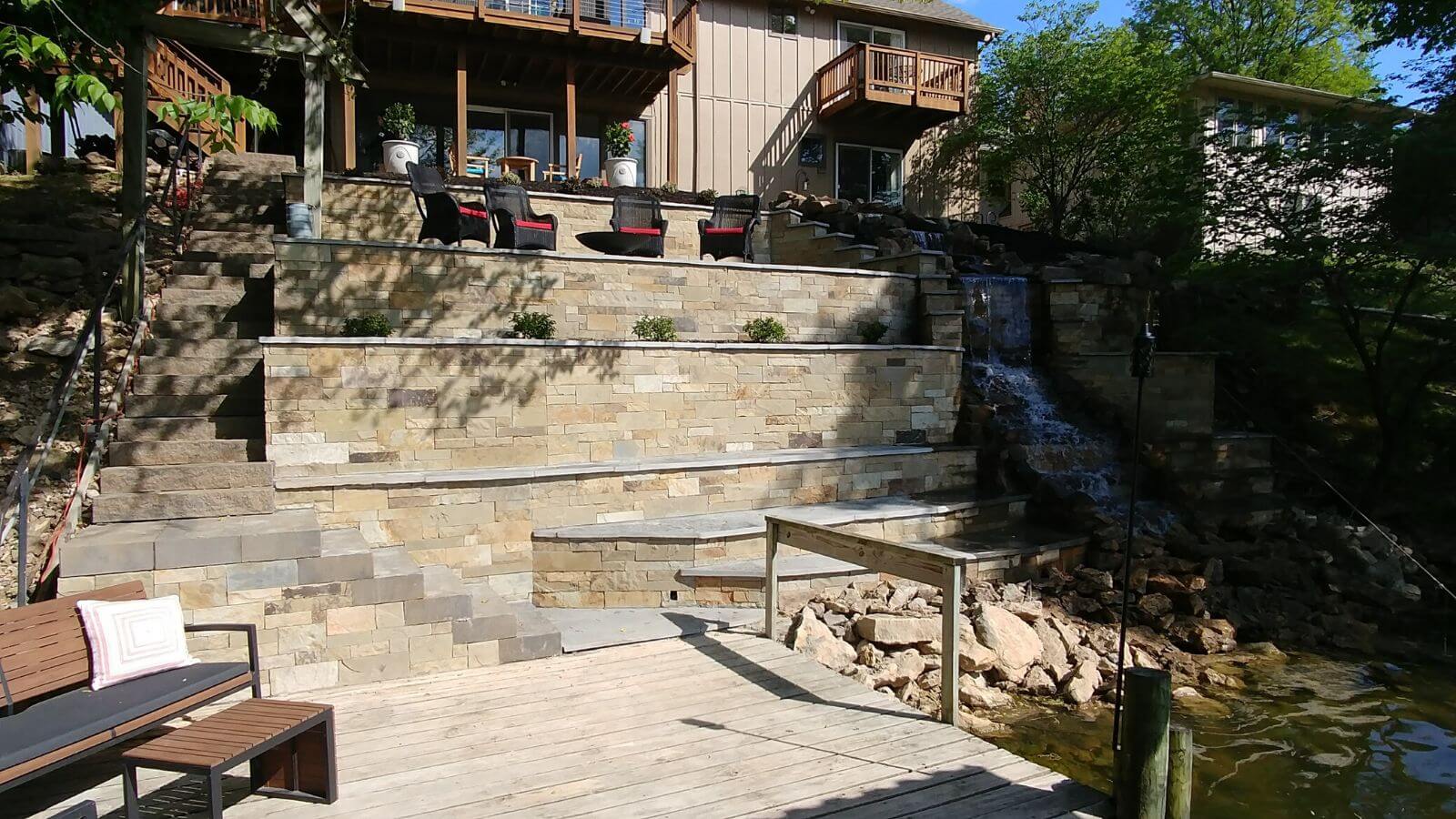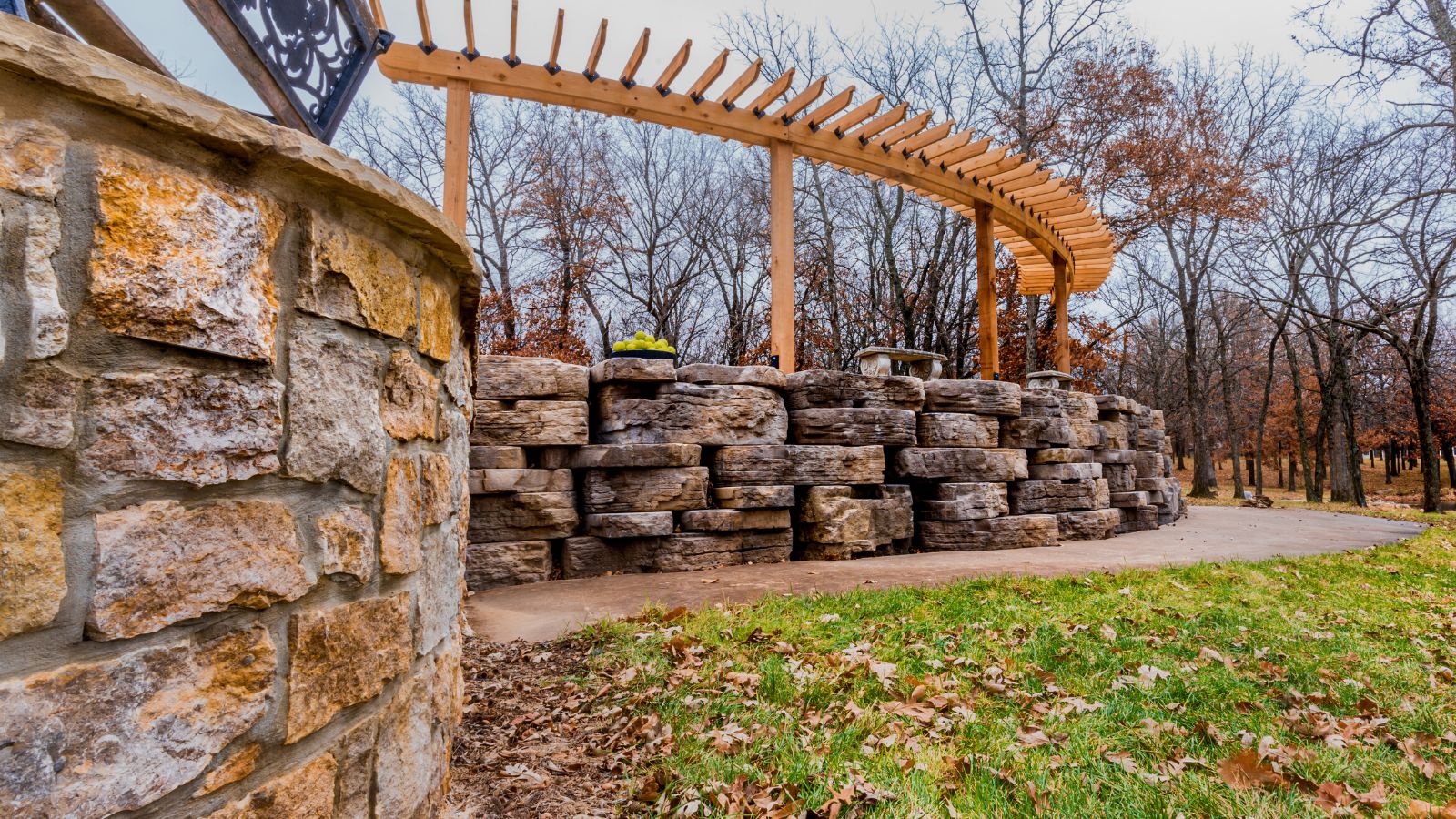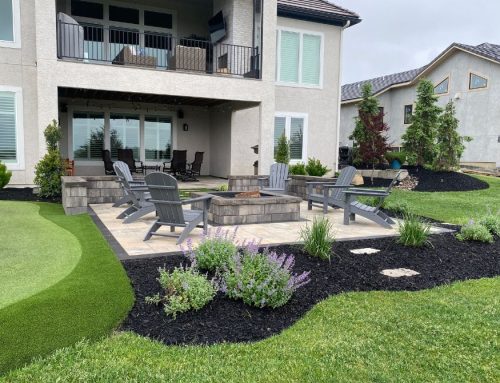There are many different types of retaining walls; however, their main purpose is to retain soil. These structures offer practical benefits for your home and are a fantastic landscaping feature that adds style to your outdoor space. From preventing soil erosion to creating level ground, these structures can help to transform your property while playing a practical role in protecting it. In this blog, we’ll explore the types of retaining walls, different styles, and how incorporating retaining walls into your landscape design can be beneficial.
What Is a Retaining Wall?
A retaining wall is designed to hold or retain soil in place so when there is an elevation difference between two areas, it does not erode. They are usually constructed from masonry, stone or concrete blocks, natural stones, or railroad ties. This type of structure helps prevent soil erosion and provides an aesthetically pleasing solution when attempting to create level ground or support structures such as patios or walkways.
How Retaining Walls Help Prevent Erosion
Good drainage around a home or business is essential for avoiding flooding, maintaining landscaping features, and helping protect foundations. But sometimes, the land’s topography doesn’t allow water to flow quickly away, creating runoff and possible erosion problems. Retaining walls act like dams that stop water from spreading out too quickly by creating channels that direct water away from properties at a safe rate. With their ability to minimize runoff and reduce erosion, they play an essential part in keeping our homes and businesses safe and sound!
Different Materials Used in Building Retaining Walls
The materials used in building different types of retaining walls vary depending on the purpose of the wall and the preferences of the homeowner or business owner. Popular choices include masonry (brick/block), flagstones, and pre-fabricated modular systems made from plastic or metal components that snap together without mortar. Depending on your budget and desired aesthetic look, it’s worth researching different options to decide what material best suits your needs.
Types of Retaining Walls
Retaining walls have become essential structures in civil engineering as they are used to hold back soil and prevent erosion in various applications. In addition, these walls provide stability and safety in areas where natural slopes or man-made excavations require support. Different types of retaining walls are designed for various applications based on the intended use, site conditions, and project requirements. Here are some of the most common types of retaining walls used in construction today.
Gravity Retaining Wall
The gravity retaining wall relies on its sheer weight to resist the pressure of soil, water, or other materials it holds back. These walls are usually constructed from heavy materials such as concrete or stone, and their thickness and height depend on the size of the retaining area. Gravity retaining walls have a simple design and are suitable for small residential projects.
Crib Retaining Wall
Crib retaining walls are modular units made of timber, precast concrete, or masonry. The units are stacked horizontally and vertically and held together by interlocking joints. Crib retaining walls are flexible in design and can be adapted to fit curved or angled walls. They’re also economical, and environmentally friendly.
Gabion Retaining Walls
Gabions are wire mesh baskets filled with rocks, concrete, or other materials. They can be used to create various retaining wall shapes and sizes. Gabion walls are highly durable and can withstand harsh weather conditions. In addition, they’re easy to maintain, and their permeability allows for excellent drainage.
Cantilever Retaining Wall
Cantilever walls are reinforced concrete walls that are cast in place. They have a horizontal footing and a vertical stem. The weight of the soil and any other retained materials is distributed through the footing and into the soil below. Cantilever walls are suitable for medium to large projects that require taller retaining walls.
Counter-fort / Buttressed Retaining Wall
A counter-fort or buttressed retaining wall is a reinforced concrete or masonry wall that has a series of vertical concrete or masonry columns on the backside. These columns provide additional support, allowing the wall to retain more significant loads than a cantilever wall. Counter-fort walls are suitable for large retaining walls where the pressure behind the wall is relatively high.
Anchored Retaining Wall
An anchored retaining wall is a flexible wall that uses cables or tendons to anchor the wall to the soil or rock behind it. The cables or tendons are inserted into the soil or rock and attached to the wall’s face. Anchored walls are suitable for projects that require high retaining heights or when the soil behind the wall is soft or loose.
Piled Retaining Wall
Piled retaining walls are constructed using precast concrete piles that are driven into the ground to the desired depth. The piles are then connected horizontally using precast concrete panels, which are placed between the piles. The panels are held in place by steel bars, which are drilled through the piles. Piled retaining walls are suitable for areas with poor soil conditions or when there are water issues.
Mechanically Stabilized Earth (MSE) Retaining wall
MSE retaining walls have a modular design and use reinforcing elements such as geogrids, geotextiles, or metal strips to stabilize the soil behind the wall. The reinforced soil acts as a mass to resist lateral loads and provide stability. MSE walls are suitable for sites with limited space or where excavation or slope reinforcement is required.
Hybrid Systems
Hybrid systems use a combination of different materials and techniques to create the retaining wall. For example, a precast concrete face could be combined with gabion baskets to form the wall’s core. As a result, hybrid systems can provide cost savings, greater flexibility in design, and reduced environmental impact.
Benefits of Having a Retaining Wall
Aside from their practical uses in controlling soil erosion, retaining walls bring other benefits, such as enhancing the look of outdoor living areas with extra seating space ideal for entertaining or just relaxing outdoors. Additionally, they help define flower beds, making them look more attractive. A professionally installed retaining wall will also add value to any property, increasing its overall appeal when it comes time to sell.
What To Consider When Planning Your Retaining Wall
Before starting your project, it’s crucial to factor in all associated costs, such as materials needed, labor costs involved, permits if required by local regulations, earthwork/grading services needed to prepare the site, etc. It’s also essential to research the reputation and craftsmanship of any contractors you hire, ensuring they have insurance coverage & sufficient experience working on projects similar to yours. Downplaying these factors could lead to costly repairs later.
Styles of Retaining Walls
Are you looking to add a retaining wall to your landscaping design? When it comes to style, you have many different options to choose from. Here are five great options for you to consider if you’re looking for a retaining wall on your property.
Terraced Retaining Walls
Does your outdoor space have steep slopes that are unusable? Then, installing terraced retaining walls is the perfect solution. Building these structures relies on a tie system on the inside to lock them into position and ensure they are stable.
Terraced retaining walls offer more than just useful functionality – they can also be used to design creative outdoor spaces such as raised flowerbeds or even an outdoor pond! Their construction allows you to build up various levels in your yard, giving it an appealing edge and allowing you to use otherwise unusable areas. In addition, they’re attractive and resilient, making them an all-around excellent choice for homeowners.
Concrete Retaining Walls
Adding a concrete retaining wall to your garden or outdoor space provides an efficient way to support vertical slopes and improve the look of the landscape. A strong base depth is vital for ensuring the foundation is solid and can resist wear over time, making concrete one of the most classic options because of its durability.
These walls are also not susceptible to typical weathering due to climate change, meaning they’ll remain looking great longer than other variations which need more maintenance. Furthermore, concrete retaining walls offer great flexibility in terms of design as there are multiple textures, colors, shapes, and sizes you can choose from depending on what best suits your requirements.
Rock Retaining Walls
Rock retaining walls offer a striking and unique way to level off portions of your outdoor space and create beautiful flowerbeds. These structures are typically built using rocks and stones that have space between them during the build process, filling in with soil and packing tightly for stability.
Adding plants into the soil between the rocks can help bring an extra level of strength to the wall as their roots grow while also helping to prevent soil erosion or shifting over time. When constructing a rock retaining wall, it is crucial to be aware of the surrounding environment, choosing stones or rocks that complement the landscape without detracting from its natural beauty.
Rock retaining walls tend to require less maintenance than other types of retaining walls due to their durability over time, making this an excellent long-term investment if you’re looking for something stylish yet practical – plus, they’ll add value to your property too!
Block Retaining Walls
Creating a barrier in your garden or outdoor space doesn’t have to be difficult, and block retaining walls are a great way to do it. Made from interlocking concrete units, these structures use gravity as their main source of stability to prevent overturning or sliding, even when exposed to hydrostatic pressure.
Block retaining walls come in two different styles – modular and segmented – offering several design options based on budget and preferences. Both types share the same structure, which provides the needed support for the blocks used. Additionally, they can easily blend into other landscaping elements like bushes, trees, etc.
Additionally, because blocks come in various colors and textures, there is always something to suit most individuals’ preferences, regardless of whether you want a subtle natural look, modern or contemporary!
Cinder Block Retaining Wall
Cinder blocks may not be the most attractive solution for retaining wall design, but they can provide many unique benefits for any landscaping project. This type of structure is typically constructed using steel-reinforced concrete poured into formwork with hollow cinder blocks stacked on top to form a strong and durable wall. With careful planning, these types of retaining walls can be customized post-construction to make them more visually appealing by adding a finish like stone or brick along the edges.
One significant advantage of cinder blocks is their strength and resilience from elements such as excess moisture or landslides. Steel rods are embedded within each layer of block to ensure uniformity and stability over time, making this an excellent option for areas prone to natural disasters like floods or storms.
The design versatility of cinder block allows the versatility of creating walls in sloped areas, garden beds, and other outdoor spaces. They also come in different shades and sizes, which provides flexibility in designing your desired look – especially when considering facades post-construction! These structures require minimal upkeep, making them an attractive long-term investment for residential and commercial properties.
Tips On Maintaining Your Retaining Wall
Adding a retaining wall to your property is an excellent way to add function and style to your landscaping design. With the proper installation, they can be an attractive and resilient structure that serves its purpose for years. But in order for them to last, some regular maintenance is needed. Here are five tips on how to keep your retaining wall looking its best:
Regularly check for signs of erosion or sagging. The sooner you identify an issue, the easier and it will be to repair it.
- Trim nearby bushes and trees so they aren’t growing too close to the wall. Root systems of trees and bushes can cause weakening or cracking problems over time.
- Clean off any debris that might clog up drainage systems while checking the durability of the drainage pipes themselves.
- Inspect the tiebacks periodically since these are important for providing additional strength. If there’s any sign of rust, replace them immediately.
- Consider repainting or staining your masonry retaining walls when necessary to keep them looking great.
With proper maintenance, you can help ensure your retaining wall stands strong against harsh weather conditions and soil issues!
Beautifying your Space With Different Types of Retaining Walls
As you can see, there are many different types of retaining walls and styles to fit your landscape needs. With careful planning, adding style & functionality through building decorative yet practical landscaping features like retaining walls can transform your outdoor space’s entire look and feel. In addition, it provides safety & protection! At Integrity Hardscapes, we pride ourselves on our expertise in designing and building various types of retaining walls. Our team will work with you to understand your unique project needs and recommend the best possible solution for it. Whether it’s a simple gravity wall or a more complex system like anchored or cantilever walls, we’re confident in our ability to deliver high-quality workmanship and outstanding results. If you’re thinking of adding a retaining wall to your property, feel free to contact us today to schedule a consultation with our team. Let us help you build a durable, attractive, and functional retaining wall that will add value to your space for years to come.










